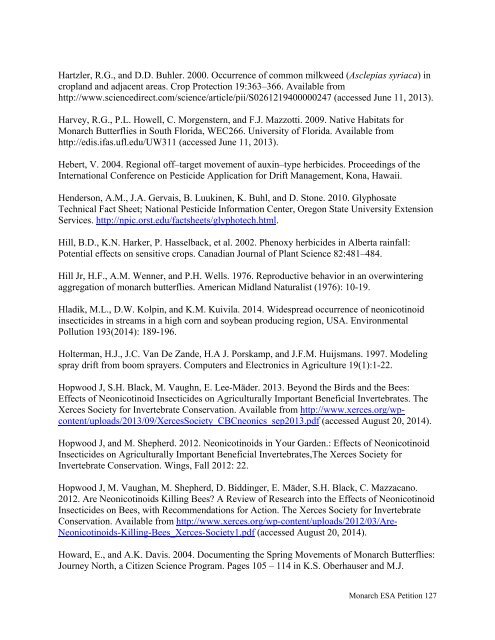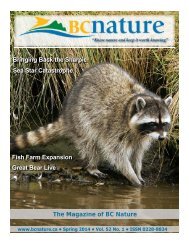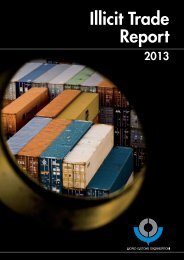monarch-esa-petition-final_61585
monarch-esa-petition-final_61585
monarch-esa-petition-final_61585
Create successful ePaper yourself
Turn your PDF publications into a flip-book with our unique Google optimized e-Paper software.
Hartzler, R.G., and D.D. Buhler. 2000. Occurrence of common milkweed (Asclepias syriaca) in<br />
cropland and adjacent areas. Crop Protection 19:363–366. Available from<br />
http://www.sciencedirect.com/science/article/pii/S0261219400000247 (accessed June 11, 2013).<br />
Harvey, R.G., P.L. Howell, C. Morgenstern, and F.J. Mazzotti. 2009. Native Habitats for<br />
Monarch Butterflies in South Florida, WEC266. University of Florida. Available from<br />
http://edis.ifas.ufl.edu/UW311 (accessed June 11, 2013).<br />
Hebert, V. 2004. Regional off–target movement of auxin–type herbicides. Proceedings of the<br />
International Conference on Pesticide Application for Drift Management, Kona, Hawaii.<br />
Henderson, A.M., J.A. Gervais, B. Luukinen, K. Buhl, and D. Stone. 2010. Glyphosate<br />
Technical Fact Sheet; National Pesticide Information Center, Oregon State University Extension<br />
Services. http://npic.orst.edu/factsheets/glyphotech.html.<br />
Hill, B.D., K.N. Harker, P. Hasselback, et al. 2002. Phenoxy herbicides in Alberta rainfall:<br />
Potential effects on sensitive crops. Canadian Journal of Plant Science 82:481–484.<br />
Hill Jr, H.F., A.M. Wenner, and P.H. Wells. 1976. Reproductive behavior in an overwintering<br />
aggregation of <strong>monarch</strong> butterflies. American Midland Naturalist (1976): 10-19.<br />
Hladik, M.L., D.W. Kolpin, and K.M. Kuivila. 2014. Widespread occurrence of neonicotinoid<br />
insecticides in streams in a high corn and soybean producing region, USA. Environmental<br />
Pollution 193(2014): 189-196.<br />
Holterman, H.J., J.C. Van De Zande, H.A J. Porskamp, and J.F.M. Huijsmans. 1997. Modeling<br />
spray drift from boom sprayers. Computers and Electronics in Agriculture 19(1):1-22.<br />
Hopwood J, S.H. Black, M. Vaughn, E. Lee-Mäder. 2013. Beyond the Birds and the Bees:<br />
Effects of Neonicotinoid Insecticides on Agriculturally Important Beneficial Invertebrates. The<br />
Xerces Society for Invertebrate Conservation. Available from http://www.xerces.org/wpcontent/uploads/2013/09/XercesSociety_CBCneonics_sep2013.pdf<br />
(accessed August 20, 2014).<br />
Hopwood J, and M. Shepherd. 2012. Neonicotinoids in Your Garden.: Effects of Neonicotinoid<br />
Insecticides on Agriculturally Important Beneficial Invertebrates,The Xerces Society for<br />
Invertebrate Conservation. Wings, Fall 2012: 22.<br />
Hopwood J, M. Vaughan, M. Shepherd, D. Biddinger, E. Mäder, S.H. Black, C. Mazzacano.<br />
2012. Are Neonicotinoids Killing Bees? A Review of Research into the Effects of Neonicotinoid<br />
Insecticides on Bees, with Recommendations for Action. The Xerces Society for Invertebrate<br />
Conservation. Available from http://www.xerces.org/wp-content/uploads/2012/03/Are-<br />
Neonicotinoids-Killing-Bees_Xerces-Society1.pdf (accessed August 20, 2014).<br />
Howard, E., and A.K. Davis. 2004. Documenting the Spring Movements of Monarch Butterflies:<br />
Journey North, a Citizen Science Program. Pages 105 – 114 in K.S. Oberhauser and M.J.<br />
Monarch ESA Petition 127




